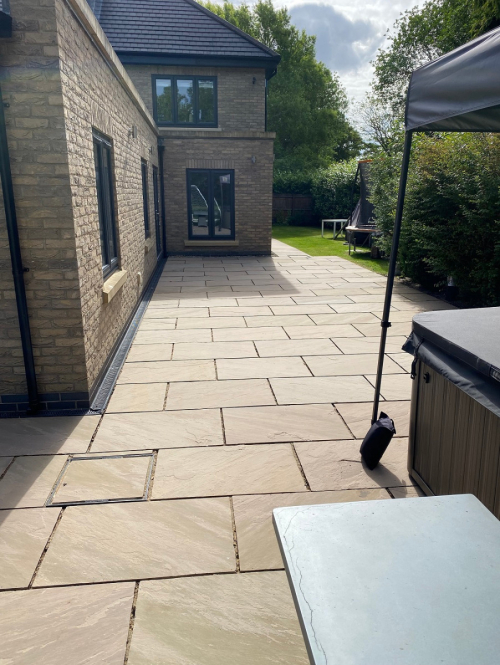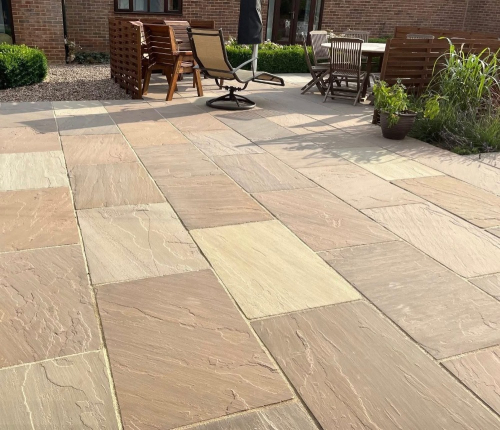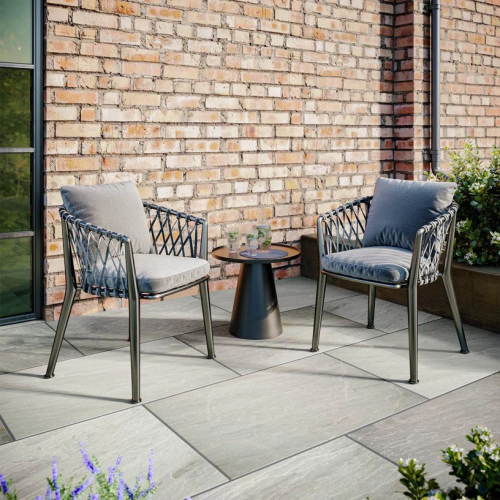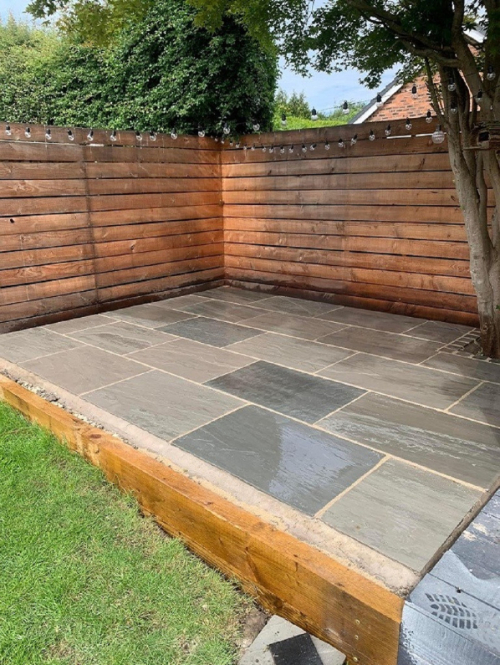Single Size Sandstone
Do you love the appearance of Indian Sandstone Paving slabs but want them all in one single size? We have a beautiful collection of hand dressed riven natural stone patio paving as well as sawn smooth honed Indian Sandstone paving available in 600x900 single size. The larger individual paving slabs can create a more contemporary look however they also look great in period classical property garden areas. Browse our stunning garden patio paving slabs today and remember we have samples available of all of our pavers so rest assured you can see the product yourself to make sure you choose the correct colour paving for you project.
If you would to like to find out more about our Indian Sandstone Paving Stones or Outdoor Porcelain Paving Slabs please contact one of our paving experts today.
Speak to a member of our friendly sales team today on 01482 688008 or Email sales@meltonstone.co.uk
600x900 Single Size
What colours are most popular for Indian sandstone?
Indian sandstone is known for its wide range of natural colours, and there are several popular colour options that appeal to homeowners, landscapers, and designers. The most popular colours for Indian sandstone include:
1. Rippon Buff or Beige: Rippon Buff or beige tones are among the most popular choices for Indian sandstone. These colours provide a warm and neutral backdrop that complements various outdoor settings and architectural styles.
2. Kandla Grey: Shades of grey, ranging from light grey to charcoal grey, are also highly favoured for Indian sandstone paving. Grey sandstone can create a modern and contemporary look, blending well with both traditional and modern landscapes.
3. Raj Green: Raj Green is a specific colour blend of Indian sandstone that features a mix of warm brown, green, and grey tones. This versatile colour option provides a natural and organic appearance.
4. Mint: Mint sandstone exhibits beautiful greenish tones, giving it a fresh and lively look. It can add a unique touch to outdoor spaces and garden areas.
5. Autumn Blend: Autumn Blend is a mix of earthy and warm colours, including rust, brown, and beige. This colour option adds richness and depth to the paving and can create a natural and inviting atmosphere.
6. Modak: Modak sandstone features reddish-brown and pinkish tones. Its vibrant and earthy colours make it a popular choice for adding character and warmth to patios and garden paths.
7. Fossil Mint: Fossil Mint sandstone has warm beige tones with fossil-like imprints on its surface, creating a fascinating visual appeal.
It's essential to keep in mind that the specific colours and variations in Indian sandstone can vary depending on the quarry source and the region where it is mined. Natural stone always exhibits unique characteristics, and the colours may be influenced by the mineral content and geological factors. When selecting Indian sandstone, it's recommended to view samples or images from your chosen supplier to get a better sense of the colours and their visual impact in different lighting conditions. This will help you choose the perfect colour option that complements your landscape design and matches your aesthetic preferences.
Can I cut Indian Sandstone with a grinder?
Yes, you can cut Indian sandstone with a grinder, and it is a common method used for shaping or resizing the stone during installation or other projects. An angle grinder equipped with a diamond-tipped cutting blade is the most suitable tool for cutting natural stone, including Indian sandstone.
Here are some steps to follow when cutting Indian sandstone with a grinder:
1. Safety Precautions: Before starting, make sure to wear appropriate safety gear, including safety goggles, ear protection, a dust mask, and sturdy work gloves. Safety should be a top priority when using power tools.
2. Mark the Cut Line: Use a pencil or chalk to mark the cut line on the Indian sandstone. Ensure that your measurements are accurate to achieve the desired cut.
3. Secure the Stone: Place the Indian sandstone on a stable surface, such as a workbench or sawhorses. Use clamps or a secure grip to hold the stone in place to prevent movement during cutting.
4. Install the Diamond-Tipped Blade: Replace the regular cutting blade on your angle grinder with a diamond-tipped cutting blade designed for stone.
5. Adjust the Grinder: Make sure the grinder is unplugged before changing the blade. Follow the manufacturer's instructions to properly install the diamond blade onto the grinder.
6. Make the Cut: Turn on the grinder and carefully guide the diamond blade along the marked cut line. Let the blade do the work and avoid excessive pressure, which could lead to blade damage or uneven cuts.
7. Cool the Blade: To prevent overheating and extend the life of the diamond blade, periodically dip it in water during cutting. This process is known as wet cutting.
8. Finishing: Once the cut is complete, check the edge for any rough spots. You can use a rubbing stone or a sanding block to smooth the cut edge if needed.
9. Clean Up: After cutting, turn off the grinder and allow the blade to stop spinning before setting it aside. Clean up any dust or debris from the cutting area.
Always exercise caution and practice proper cutting techniques when using power tools. If you're uncertain about cutting Indian sandstone or lack experience with using grinders, consider seeking the assistance of a professional stone cutter or masonry contractor to ensure accurate and safe cutting.
Is brush in grout good for Indian Sandstone?
Using brush-in grout can be a suitable option for Indian sandstone paving, depending on the specific characteristics of the sandstone and the joint width between the pavers. Brush-in grouts, also known as resin-based jointing compounds or polymeric sand, are commonly used for filling the joints between pavers in outdoor applications.
Here are some considerations when using brush-in grout for Indian sandstone:
1. Joint Width: Brush-in grout is most effective for joint widths typically ranging from 1/8 inch (3 mm) to 1/2 inch (12 mm). If the joint width is too narrow or too wide, the effectiveness of the brush-in grout may be compromised.
2. Stabilization: Brush-in grout can stabilize the joints and help inhibit weed growth, reducing maintenance efforts.
3. Water Permeability: Some brush-in grouts allow water to pass through, allowing better drainage. This can be beneficial for preventing water pooling and potential surface damage.
4. Ease of Installation: Brush-in grouts are generally straightforward to apply, requiring a simple brushing technique to fill the joints.
5. Colour Options: Brush-in grouts are available in various colours, allowing you to choose a colour that complements or enhances the appearance of your Indian sandstone paving.
6. Proper Application: Ensure that the sandstone pavers and the joints are clean and dry before applying the brush-in grout. Follow the manufacturer's instructions for the best results.
It's important to note that not all brush-in grouts are suitable for all types of natural stone, including Indian sandstone. Some brush-in grouts may contain additives or polymers that could potentially discolour or harm the sandstone. Therefore, it's crucial to select a brush-in grout specifically designed for use with natural stone and, if possible, check with the manufacturer to confirm its compatibility with Indian sandstone.
As with any paving project, it's advisable to do a small test or consult with a professional stone supplier or installer to ensure that the chosen brush-in grout is appropriate for your specific type of Indian sandstone and the intended application. Properly installed and maintained brush-in grout can contribute to the longevity and beauty of your Indian sandstone paving.
Is natural stone paving hard to keep clean?
The ease of keeping natural stone paving clean depends on various factors, including the type of natural stone, the finish, the location of the paving, and the maintenance routine. Here are some general considerations regarding the cleanliness and maintenance of natural stone paving:
1. Porosity: Natural stones like limestone and sandstone can be more porous, meaning they have small pores and capillaries that can absorb liquids and stains. Porous stones may require more attention to prevent staining and to clean spills promptly.
2. Sealing: Some natural stones benefit from sealing, which helps reduce their porosity and makes them more resistant to stains and moisture. Sealing can simplify cleaning and maintenance efforts, especially for outdoor areas exposed to weather and spills.
3. Surface Finish: The finish of the natural stone can affect its ease of cleaning. Smooth, polished surfaces may be easier to clean compared to rough or textured finishes.
4. Regular Cleaning: Regular sweeping or using a leaf blower to remove debris from the surface of the natural stone paving is essential. Frequent cleaning prevents dirt and debris from becoming embedded in the pores of the stone.
5. Stain Removal: Address spills and stains promptly by cleaning with mild soap and water or a suitable stone cleaner. Avoid using harsh chemicals or abrasive tools that can damage the stone.
6. Preventative Measures: Using mats or rugs in high-traffic areas can help reduce dirt and debris from being tracked onto the natural stone paving. Placing coasters under plant pots or outdoor furniture can prevent water stains.
7. Algae and Moss Growth: In shaded or damp areas, natural stone paving may be susceptible to algae or moss growth. Regularly clean and remove any growth to prevent slip hazards and maintain the appearance.
Overall, while natural stone paving may require a bit more attention than some other materials, it can be kept clean and well-maintained with a regular cleaning routine and appropriate care. Properly selected and installed natural stone with the right finish and sealing can offer durable and visually appealing outdoor surfaces that stand the test of time with proper care.
What size packs do Indian sandstone pavers come in?
Indian sandstone pavers typically come in packs or crates with a predetermined assortment of sizes to facilitate easier installation and create visually appealing patterns. The pack sizes for Indian sandstone pavers can vary depending on the supplier or manufacturer. However, the most common pack sizes include:
1. Single Size Packs: These packs contain pavers that are all the same size. For example, a single size pack may include only 600x600mm pavers. This option is ideal for projects that require uniformity in the layout.
2. Project Packs: Project packs contain a mix of different-sized pavers, allowing for more versatility in creating patterns and designs. The most common project pack sizes are:
- 4 Size Project Packs: These typically include four different sizes, such as 900x600mm, 600x600mm, 600x290mm, and 290x290mm pavers.
Project packs offer flexibility in design and allow for various laying patterns, such as random layouts, stretcher bonds, and herringbone designs.
It's essential to check with the specific supplier or manufacturer to determine the exact pack sizes and the range of paver sizes included in each pack. When planning your project, consider the area you need to cover, the layout pattern you want to achieve, and the pack sizes available to ensure you have the right quantity and variety of pavers for your landscaping or paving project.
What colour is Kandla?
Kandla is a type of Indian sandstone that is known for its natural and rustic appearance. It is typically found in various shades of grey and brown, with tones ranging from light grey to dark brown. Kandla sandstone may also exhibit subtle variations in colour and veining, adding to its visual appeal and charm.
The specific colour variations in Kandla sandstone can depend on the quarry source and the region where it is mined. Different batches of Kandla sandstone may have slightly different colour characteristics due to the natural variations in the stone.
Overall, Kandla sandstone's neutral and earthy tones make it a popular choice for outdoor paving, landscaping, and other construction projects. Its natural colours blend well with various architectural styles and complement different types of outdoor spaces. When using Kandla sandstone, it's essential to view samples or images of the stone to get a more accurate representation of its colour and appearance in different lighting conditions.





